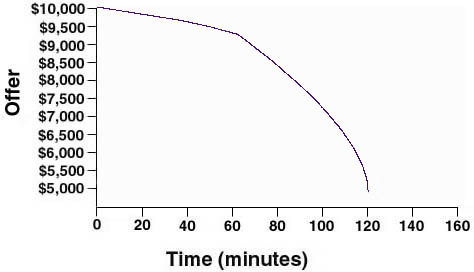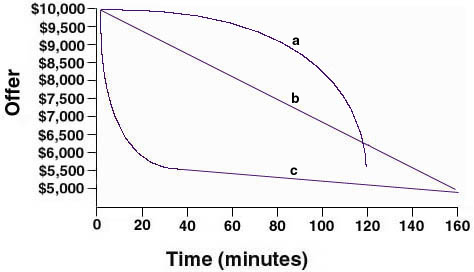
Another type of concession curve might occur when a person makes very small concessions early on -- she hopes that the other side will make most of the concessions. She shifts strategy and makes large concessions only when a long period of time has passed, such as when a deadline draws near. Then the person resigns herself to the conclusion that, in order to secure a deal, perhaps large concessions are in order.

For example, suppose that your used car dealer made only very small concessions early on.
During the first hour of negotiation, he moved from $10,000 to $9,400 -- an average rate
of $100 every 10 minutes. During the next hour, however, the dealer conceded a average
amount of $1000 every 10 minutes (maybe he was in a hurry to go to lunch and wanted to
"wrap up" the deal). His concession curve looks a something like a number
"7" -- with a fairly flat rate early on, followed by steep declines.

This type of dealer may hope that you will make the large concessions early in the negotiation and they will secure a favorable outcome on their own terms. Or maybe they don't expect either side to make large concessions early on -- small concessions may be viewed as part of the "ritual dance" of bargaining and serious negotiation will occur later.
Combination Curves
So far, we have covered three broad "types" of concession curves:
-Straight lines, where concessions are made at a constant rate
-"L" shaped curves, where concessions are large early in the negotiation and
then become small near the end, as a signal that the person has made virtually all of the
concessions that they intend to make.
-"7" shaped curves, where concessions are small early in the negotiation and
then become large near the end, as a signal that it is time to make "serious
concessions," usually because a deadline is near.

| Review question: | ||
|---|---|---|
| Which curve is an "L" - shaped concession curve? | ||
|
|
Curve a | |
|
|
Curve b | |
| Curve c | ||